To Prop or Not to Prop?
For many yoga students, the idea of using a prop to help them achieve or stay in a yoga pose seems like cheating.
The inner dialogue may go something like, “I can do this pose! I don’t need no stinking prop! Props are used in restorative yoga classes, but I am not broken—why would I use a prop?”
If we change our point of view slightly, to consider a functional approach to our yoga practice (as opposed to an aesthetic approach where looking “right” is what matters), then our view of props may radically change as well. Do we really care if a little extra help is needed to get sensation into the targeted area: if props can help—let’s use props!
As we shall see, there are many creative and wonderful ways to use props to help achieve our intentions in yoga. First we will look at why we would want to use a prop in our practice, then we will look at the various kinds of props available, and, finally, we will look at a video showing examples of using props in many popular Yin Yoga postures.
Benefits of Props
There are several key benefits and reasons for using props in our asana practice:

- To increase stress in desired areas
- To decrease stress in undesired areas
- To create length and space
- To make certain positions available/accessible
- To provide support: when the bones feel supported, the muscles can release
- To increase comfort: which means longer stays in the postures
When we take a functional approach to yoga practice, we decide what area we want to target; we decide where we want to apply a stress to the body and the nature of the stress (either a stretching kind of stress, called tension, or a compressive form of stress, called compression.) If we cannot get the level of stress we desire in the targeted area, then we can either choose a different posture or we can employ props. Props can help to increase stress where there is too little or none at all, and props can also assist in decreasing stress if there is too much.
Through applying stress in an intelligent way, props can help to lengthen or open the body, creating more room to move. One example would be to use sandbags on an inner thigh in Half-Butterfly (as shown here), which will add a bit more juice to the adductor muscles and inner thigh’s fascial network. With this extra space, it may be easier for a student to now add pelvic flexion, and fold forward.
Props may also make certain poses possible. There are a number or reasons why a student may not be able to stay in a pose long enough to achieve the desired stress that the pose has to offer. One reason is the body’s own proportions.
For example, in the Baby Dragon, some students’ arms are shorter than their shinbones, and they cannot easily rest their hands on the floor. This means that all the students’ upper body weight is supported in the hips socket, which is fine, but it is not fine if the stress there is too much. For other students, the compression of the top/front of their pelvis (called the ASIS = anterior, superior iliac spine) onto their thigh (the femur) is very painful or uncomfortable, and they will not enjoy staying in this position for very long. Their body will tighten up to avoid the discomfort, which is exactly the opposite intention of the pose. We want to be able to relax and bear it, not contract and swear at the teacher. In either case, using blocks under the hands allows the student to back off a bit and reduces the stress of the pose enough so that she can stay.
One of the principles in Yin Yoga is that we relax the muscles so that the stress of the posture soaks into the deeper connective tissues. If the muscles are engaged, they will take up the stress, which reduces the stress in the targeted areas. (To understand why, visit this section of YinSights, which explains why we prefer to do Yin Yoga with relaxed muscles.)
Sarah Powers has a way of explaining this principle, “When the bones feel supported, the muscles can relax.” Thus, another benefit to the use of props is that the bones are supported, so the muscles can release. Very experienced yogis miss out on this: they feel that they are so open and flexible already that they don’t need to use props, but if they were to just try placing blocks under their knees in Butterfly, they might be surprised just how much muscular engagement they were employing before. Now, with the bones supported, the muscles relax more completely and the stress of the pose goes deeper into the fascia.
Of course, the magic of Yin Yoga is time: we linger long in the delirious delicacy of the postures. Props can assist in lengthening the lingering. The intention in Yin Yoga is to arrive an appropriate edge and stay (what is appropriate is defined as the Goldilocks’ position: not too little and not too much). But if the edge is a bit too strong, we won’t be able to stay. Using a prop may take just enough edge off the pose to allow us to marinate longer. This is not an excuse to back off so much that you don’t feel any stress at all; we need stress, just not too much stress. Time is more important than intensity, so backing off a little, by using a prop so we can linger longer, is a good trade-off.
The Panoply of Props
These six reasons for using props allows us to get the most from our Yin Yoga practice. But, there is no definitive definition describing what we can use as a prop. There are certain props that are commonly found in yoga studios, but there are many things that can be used in uncommon ways. Below is a list of both standard and esoteric props that can be employed creatively:
| Standard Props | Esoteric Props |
| Cushions | Dowels & Towels |
| Blocks | Balls & Walls |
| Bolsters | Chairs & Stairs |
| Straps | Ropes |
| Blankets | Books as blocks |
| Sandbags | Handbags |
| Yoga Mats, Furniture, Partners, Pets, … |
This is not an exhaustive list!
But, it is sufficient to get us started at looking at how to use these props in a wide variety of ways. Remember your intentions! We want to use the props to help us access the targeted area for the poses or to help us stay in the pose longer. If a prop doesn’t help us stay longer or if it doesn’t help us to feel the pose where we want to feel it, there is no point in using the prop.
Cushions:
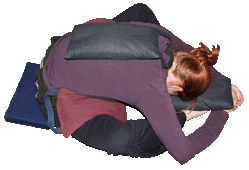
The standard use of cushions is to help us gain height. We can sit up taller, which allows a more natural curve to the lumbar spine. Sitting taller also changes our orientation in the field of gravity when we start to fold forward. When we tilt forward gravity does the work of drawing us down.
If we are constrained by tight hamstrings when sitting and cannot even get to a 90° flexion of our hips, let alone go beyond 90°, then a cushion makes all the difference. The extra height changes our orientation enough that gravity comes into play. A common example is found in Butterfly. Many stiffies can’t flex the pelvis enough to come forward, if they are sitting on the floor. They will strain with their stomach muscles and hip flexors to stay sitting upright. However, propping a stiff guy up on a cushion changes his orientation enough that he can now relax and let gravity do the work.
Blocks:
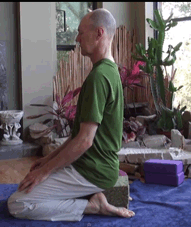
Similar to cushions, blocks add height or length to the body, making more poses available and effective.
Blocks are generally higher/thicker than cushions but they are harder and thus less comfortable. Sitting on a cushion may not be enough for someone to reach their “tilting point” where gravity can take over, so placing multiple cushions together or a block on top of the cushion may be required.
Sometimes, when we try sitting is Seiza (one of the main Japanese meditation postures), also called Vajrasana in Yoga, sitting with a block or two between our feet makes the pose more accessible.Blocks are also useful for simple support: you can rest blocks under bent knees in forward folds, like Straddle or Caterpillar, to allow the bones to relax and thus the muscles to soften. Blocks are great and you may want to have several on hand when you do a Yin Yoga practice.
Bolsters:
Similar to blocks, bolsters also help to take stress off the bones. Where blocks can add height or length to the body, bolsters are mostly used to relax the body in the postures. Remember, the bones don’t like to be left hanging: the muscles will engage to support them. But we want the muscles to relax, so a bolster under the bones accomplishes this. A good example is the challenging pose of Saddle. For many people, who can’t quite come all the way to the floor, a bolster under the spine allows them to relax in this pose.
Bolsters can be used to prop the body in many ways: the upper body can relax when folding forward onto a bolster, such as in Half-Butterfly (see picture above).
Straps:
Straps are great for preventing unwanted movement, and, when folded several times, for prying open the body.
A good example of the first intention, as shown in the accompanying video, is Wall Straddle, where the legs normally are allowed to just fall away towards the floor. However, for many students that is too far and too intense. Using a strap (or two in this case) allows the student to come to an appropriate edge, and then relax without having to use her muscles to keep her there. 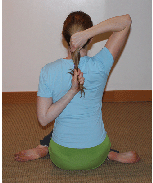 When folded over, straps can be used to keep two parts of the body separate, such as when we employ a strap behind the knees in Half Butterfly (useful for students who suffer knee pain when the knee is fully flexed), or between the hip and thigh in Dragon Poses (for students who feel a painful or uncomfortable pinching there.)A final common use of a strap is to create greater reach.
When folded over, straps can be used to keep two parts of the body separate, such as when we employ a strap behind the knees in Half Butterfly (useful for students who suffer knee pain when the knee is fully flexed), or between the hip and thigh in Dragon Poses (for students who feel a painful or uncomfortable pinching there.)A final common use of a strap is to create greater reach.
For example, in Shoelace (aka Cowface) when we want to clasp our hands behind our back, but can’t quite reach, a strap bridges the gap (and here creativity is allowed! If a proper Lululemon yoga strap is not available, use a necktie, or a towel, or a ponytail. Even strong socks can serve—just wash them before offering them to your students.)
Straps are used often in Hatha Yoga classes to help students reach the feet in straight-legged seated poses, or supine backbends where the intention is to reach back for the feet (think Bow Pose.) Straps looped around the feet make the feet accessible.
Blankets:
Blankets can keep us warm. Nothing surprising about that! We use them for shavasana for that reason, but Yin Yoga is a cool practice, and we can use blankets to keep us warm and comfortable while we marinate in the uncomfortable postures. Beyond their heat regulating properties, blankets can be used like cushions (just fold them up a couple of times) or like bolsters (just roll them up into cylinders), but they can be used as unique foundational supports as well.
In the Hatha world, blankets are recommended for many inversions, such as Shoulder Stand or Plough pose, to raise the shoulders, allowing the head to remain on the floor. This changes the angle of the neck and makes the pose less stressful for the neck. We can use a folded blanket in the same way in the Yin Yoga posture called Snail.Blankets, in Yin Yoga, can also be used in place of a regular yoga mat. We don’t do standing postures in Yin Yoga, so we don’t really need a sticky yoga mat, but a nice soft blanket underneath us may make poses like Frog possible.
Blankets can cushion the knees and allow them to slide apart. For the same supporting reasons, a blanket under the back knee in Dragon lunges or Swan may make the pose possible for students who suffer kneecap pain.
Sandbags:
Sandbags add resistance and weight. Remember, one of the key principles in Yin Yoga is to find that edge and linger. But for many people, they come into a pose and there is no real edge there. Sandbags can help make the postures juicier (but remember, also, the Goldilocks’ principle…don’t get too juicy!)
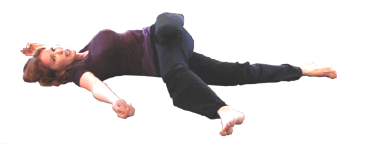
Sandbags on the inner thighs in Butterfly or Half Butterfly can add that little bit extra you may be craving. Placing a sandbag along the spine in Half Butterfly or Child’s Pose can add more stress, and can feel quite lovely. Sandbags can also create stability and prevent us from slipping out of poses. Bananas can be slippery, but strategically placing a sand bag beside the feet can help anchor them in place. A sand bag on the bent knee in a Reclining Twist can anchor that knee, even if a bolster underneath the knee already props it up.
Esoteric Props:
As long as you remember the intention behind the use of props, you will find that you can use many things as props. Instead of a sandbag to restrain your movement, you can use walls, or some heavy piece of furniture.
(Think again of Bananasana: use a wall or the leg of your sofa to stop your feet from sliding out of the pose.)
There are many things you can use to support you and help you stay in a pose: a yoga mat, rolled up, can be a cushion, block or bolster. Your dog or husband can be a nice bolster under your lower back for a supported bridge. If you don’t have a bolster or small child handy, use a chair or a coffee table for leaning on in forward folding seated poses. You can do the Swan with your front leg on a stair, or a chair, or the kitchen counter. Get creative, but remember your intentions.
You can do too much of anything! Our intention is not to move into pain. Sometimes pain is not experienced right away, while in the pose. Sometimes pain arises the next day. Be alert. If you feel that you have gone too deep in your practice, or lingered too long, back off. Just because you are using props does not mean that you can’t hurt yourself. You can, so pay attention and remember your intention.
With all this as prologue, are you ready to prop yourself up? Let’s go then! We will look at how we can use these props in your Yin Yoga postures. At YinYoga.com, there is a section that looks at the 25 or so most commonly used Yin Yoga asanas.
Props Applied
Here, each asana is broken down into subtopics discussing why you would want to do this pose, who should be careful of this pose (contraindications), how to get into and come out of the pose, variations and options, and other detail about the posture. For about a dozen postures we also have video descriptions explaining the poses, and there you will find many of our props being used. You can also view this video in which Diana Batts helps explain many different ways props can be used in the most common Yin Yoga asanas.
Love elephant and want to go steady?
Sign up for our (curated) daily and weekly newsletters!
Author: Bernie Clark
Editor: Renee Picard
Photos: all via the author
 Share on bsky
Share on bsky
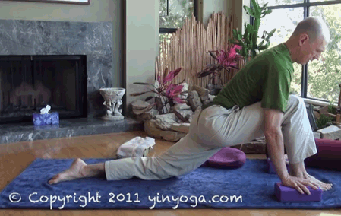





Read 0 comments and reply